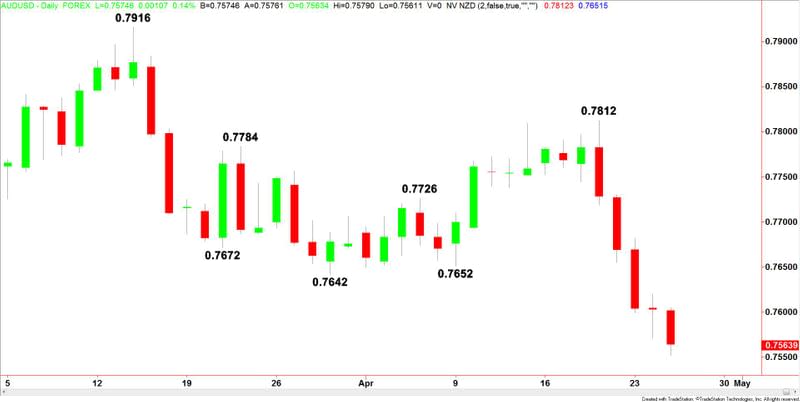AUD/USD and NZD/USD Fundamental Daily Forecast – Will Short-Sellers Use GDP Report as Excuse to Book Profits?
The Australian and New Zealand Dollars continued their lengthy price slide on Wednesday as domestic data this week failed to generate any buying interest with investors clearly focused on the direction of U.S. Treasury yields.
The AUD/USD settled on Wednesday at .7564, down 0.0039 or -0.51% and the NZD/USD closed at .7069, down 0.0050 or -0.70%.

The contrast in central bank policy is also driving the Aussie and Kiwi lower. Simply stated, the U.S. Federal Reserve is widely expected to raise interest rates at least two more times this year, while the Reserve Bank of Australia and the Reserve Bank of New Zealand are in no hurry to raise rates. This is helping to make the U.S. Dollar a more attractive investment.
The catalysts driving U.S. yields higher are worries about the growing supply of government debt and inflationary pressures from rising oil prices.
U.S. government debt yields rose on Wednesday, with the rate on the benchmark 10-year Treasury note inching above the psychological 3 percent level it hit Tuesday for the first time since 2014. Late Wednesday, the yield was hovering around 3.028 percent, down from 3.033 percent hit earlier in the session, its highest level since January 2, 2014. Traders and speculators may be targeting 3.05 percent, the T-note’s highest level since 2011.

Forecast
Although the focus should continue to be on the U.S. Dollar and Treasury yields, traders will get the opportunity to react to economic data on Thursday.
Earlier in the session, Australia’s import prices increased at a faster-than-expected pace in the three months ended in March, figures from the Australian Bureau of Statistics showed.
The import price index climbed 2.1 percent sequentially in the first quarter, following a 2.0 percent slight rise in the fourth quarter of 2017. It was the second consecutive quarterly increase. Economists were looking for a 1.2 percent increase.
On a yearly basis, import prices grew at a faster rate of 2.3 percent in the March quarter, after a 1.4 percent gain in the December quarter.
Data also revealed that export prices rose 4.9 percent quarterly in the first quarter, following a 2.8 percent increase in the prior month. As compared to the corresponding period last year, the index dropped by 1.4 percent.
In the U.S., traders will get the opportunity to react to the latest data on Durable Goods, Weekly Unemployment Claims, Goods Trade Balance and Preliminary Wholesale Inventories.
Essentially, rising U.S. Treasury yields and U.S. Dollar should continue to put pressure on the AUD/USD and NZD/USD. However, we could see some short-covering and position-squaring if the U.S. data misses their mark or if investors decide to book profits ahead of Friday’s U.S. GDP report.
This article was originally posted on FX Empire

 Yahoo Finance
Yahoo Finance 